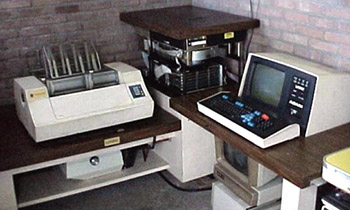
The Adam was the first computer released by Logical Machine Corporation (LOMAC) in 1975. In 1978 they also produced Tina which stands for "TINy Adam". In 1983 Logical released the David, and the L-XT in 1983. There was also the Goliath, a data storage server with 5MB hard drive. Goliath could be connected to up to 20 Davids or Tinas. David and Goliath names makes a clear reference to the mythical story found in the biblical Book of Samuel.
The Adam computer is considered a "mini" computer, as these kind of systems were called at the time. It was quite compact compared to larger computers sold in the mid 70s. The entire system is housed in a L-shape desk. On the left part was the printer, on the right the display and keyboard, and systems cards underneath the desk. In the corner was the big hard disk.
The most original feature of the Adam is not its hardware, buts its operating system and language ! The Adam was self-proclaimed the first "programmerless" computer.
Logical Business Machines was an american company based in Sunnyvale, California. It was founded by John Peers, prior to buying ‘The Byte Shop’ franchise, one of the first successful chains of personal computer stores, which was started by Paul Terrell (who was the first retailer to sell the original Apple 1 computer). His studies in human learning in the 70s led him to a neurological emulations approach in computing, now better-known as neural networking technology. In 1982, Mr. Peers also founded Novix, Inc., specializing in the design of high-speed microprocessors and software optimized for neural and massive parallel computing. John McAfee was vice President of engineering at Logical (at least in 1983/1984).
This historical background is necessary to explain why the Adam computer was so special. The philosophy behind the Lomac systems and its operating system/language is that the user is not necessarily a computer expert. Thus the system let the user create its own language based on verbs, words, nouns, numbers or expressions, a bit like with Forth language. Verbs call actions for example and can be used to create and index files, manipulate data, prompts the user to enter data, while nouns represent the user's data. Thus the user communicate with the computer via a "natural" language conceived by the user itself. It's the difficult to explain how it works, but the concept was revolutionary. It was an object oriented language ahead of its time. This natural language was the predecessor of PRAGMA (that is still used today).
Sadly, these computers and their concept didn't sell well and very little is known about them. Any testimonies or memories are welcome !
In 1980 September edition of Info World, Adam Osborne wrote in an article:
"One of the more colorful characters making significant contributions to the microcomputer industry is John Peers. John was the founder of Logical Machine Corporation (otherwise known as Lomac), where he took the first small step in the direction that ultimately the entire computer industry must take: toward self-programming computers. Lomac's Adam computers are programmed in English sentences you structure for yourself. This is a long way from a truly self-programming computer, but John had 20-20 future vision. Unfortunately, he spent too much of his time and his company's resources trying to raise Byte Industries from its ashes. As a result, Lomac never grew as it should have, and Byte Industries ultimate demise has merely been postponed."
|









